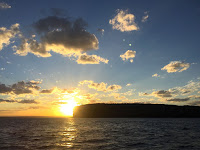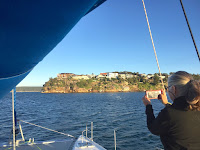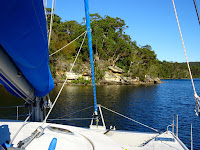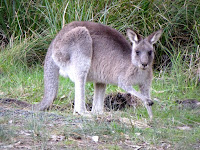As with our last sail, Maryanne woke me a few minutes early because the wind was starting to climb and get gusty. As soon as I was dressed, we reefed everything way down in preparation for my watch. In the next few hours, a cold front blew through with rain, thirty-five knot gusts and, of course, cold. Multiple wave trains were smashing against each other from different directions, which turned the whole sea into an awful, choppy mess. I was annoyed at this, but mainly concerned that Maryanne was having trouble sleeping through the commotion.




Departing Jervis Bay around Sunset, and arriving in Port Hacking which has suburbs of Sydney on the North side, and peaceful national park on the South Side
We arrived at Port Hacking just as the sun came up. The wind was blowing so hard that we could only make about two and a half knots against it with one engine. The current was also ebbing, which slowed us down even more. It took us a while, but we finally made it all of the way into the protected cove at the end of Southwest Arm. There, our wind meter read four knots and the sea was a mirror. Finally! Good to be here.
While I had a nap, Maryanne inflated the kayak, which we both set off in as soon as I stirred. Southwest Arm has a very long section that is only knee deep (at high tide), which was perfect for exploring in the kayak. Along the way we met a local (Glenn) in a small, shallow-draft, houseboat who gave us the skinny on his 'secret' waterfall.
We paddled as far upriver as we could, then we left the kayak on a rock ledge and followed a trail along the river to Winifred Falls. There wasn't much flow, but the water hopping down from one sandstone ledge to the next made for some very peaceful scenery. We then went to Glenn's secret spot, hidden away behind a host of trees at the head of the nearby tributary of Saddle Gully. It looked like the perfect little basin for a midday swim in a freshwater basin and with a waterfall to boot. We were looking forward to that one, but the day was waning, so we stopped by Glenn's boat for a quick chat and to thank him and then headed home, glad to have found such a serene spot so close to the city.






Exploring SW Arm
Our plans for a midday freshwater swim in Glenn's secret arm were foiled by the moon. The first high tide of the day was right at sunrise. That's when everything is at its coldest: water, air, rocks. No, thanks. The next was after dark, so that was out for much the same reason. The day's midday low tide was even lower than the previous day. Just to be sure, I took the kayak up the river for an exploratory paddle. No sooner had I rounded the first corner than the little keel fin was parting the sea grass. I stuck my flat hand in until my fingers touched bottom. They hit before my wrist got wet. So much for that idea.
While I was gone, Maryanne had been exchanging messages with a local woman named Daniela who had seen us, from her waterfront home, entering Port Hacking the day before and noticed that we weren't one of the usual local crowd. After a bit of sleuthing, she found our tracker and sent Maryanne a welcome and an invite to come over to her house for tea and to share some of our experiences. They had an available mooring ball right off their property and a dock for tying up our dinghy. Since the weekend was approaching, our little corner of paradise in Southwest Arm was starting to get a little crowded, so it was a good opportunity to meet new friends and leave some room for the weekenders.
We timed our arrival so that it coincided with her husband Bob's finishing his week's work. Pretty quickly, we all determined that wine made more sense than tea, beveragewise. They were great and easy company to get along with, so soon we were accepting an offer to join them and their two daughters for dinner. The TV was on; not the electric one, the picture window one.


We were well looked after by Daniela and her lovely family
Down at water level, the weekend boating crowd was busy having drag races and trying to flip their boats over. Bob says this happens every Friday night after four o'clock when the marine police go home. We were glad we weren't aboard, being tormented by their wakes. As night fell, we could see Begonia's anchor light, just about one floor down. The family was full of questions for us about our unusual lifestyle and I think we did a pretty good job of convincing them that if we can do it, anyone with their obvious intellect should be able to make a much better job of it. At the end of the night it was nice to be able to get home with only half a dozen oar strokes. The wakes were gone. We slept well.
We had an early wake up in the morning, provided free of charge by all of the fishoes in a mad hurry to get to their favorite spots. They needed to get started on their hours-long routine of sitting there with a beer in one hand. We dropped our mooring shortly after, waving goodbye to our new found friends, and headed just across the bay to Jibbon Beach, where we planned to go ashore and do a short loop hike that included some aboriginal art.


Aboriginal rock art/engraving - hard to really see, but of great cultural significance
We did see the art, which was very old and eroded and thus very subtle, but it was there. It was mostly outlines of various animals carved into the soft sandstone. In our way, we didn't just stop there. We soon were hiking the bigger loop that took us around most of the peninsula. Then, as an extra bonus, we took the trail to The Balconies, an area of the coast that is sculpted out of the multicolored layers of sandstone making up the cliffs. The area is just beautiful and provides an almost endless assortment of smooth shapes to admire which change when viewed from each new angle.








Coastal trails (Royal National Park)
When we were done, even though we were getting a bit tired, we detoured through the nearby town of Bundeena, which had a nice selection of restaurants and cafés to choose from. Even though I was hungry, I surprised myself by passing them up, opting instead for an ice cream bar from the grocery store to keep me going until I could get home to Maryanne's cooking. We made it just at sunset, when a large contingent of boats that had come for the event were just leaving again.
[Maryanne] Thinking of sailing to Port Hacking yourself? The Cruising section of the Royal Motor Yacht Club (RMYC) of Port Hacking publishes a free (downloadable) cruising guide to the area full of lots of great tips. Of course most of the South coast of Port Hacking is the lovely Royal National Park (useful to have the annual NSW NP pass).
It’s a gem of a place - easy to enter and lots of free mooring balls (see NSW Courtesy Mooring map); there are city locations and peaceful anchorages surrounded by National Park to visit.
Note: There are overhead cables at Burraneer Point reported (on Navionics) as 12m clearance - but are long replaced and now actually 24m (so shouldn’t be an issue for most cruising boats). Some parts have very windy narrow navigation ways that seem to come way too close to rocks (all is well if you follow the navigation markers). Depending on your keel depth you will need to pay attention to the tide height before entering some of the channels.
































